Edições anteriores
-

Pesquisa e Ensino em Ciências Exatas e da Natureza
v. 9 (2025)The image illustrates the essence of the scientific method and its connection to mathematical modeling in education, highlighting a dynamic process of knowledge construction. The central figure symbolizes the act of observing natural phenomena, such as the motion of celestial bodies and terrestrial objects, represented by spheres, polygons, and geometric curves. These elements evoke data collection and the human effort to interpret reality through mathematical models. The presence of formulas, vectors, and graphs reinforces the idea of systematic problem-solving, where hypotheses are tested and adjusted. The curved line connecting points and objects symbolizes the continuous process of validation and modification, essential for enhancing scientific understanding. This visual composition celebrates the birth of the scientific method as a cornerstone of education, fostering the integration of empirical observation and mathematical abstraction in the development of critical thinking.
-

Pesquisa e Ensino em Ciências Exatas e da Natureza
v. 8 (2024)The image depicts a child with Autism Spectrum Disorder (ASD) [Transtorno do Espectro Autista (TEA)] participating in invertebrate-assisted therapy (symbolized by butterflies, ladybugs and other insects), surrounded by a colorful puzzle, which refers to the symbol of ASD. Invertebrate-assisted therapy is an innovative approach that seeks to promote the well-being and emotional development of children with ASD. These little animals, with their fascinating and movement shapes, help to awaken the child's curiosity and interest, facilitating interaction and the development of social and cognitive skills in a safe and welcoming environment. The use of the puzzle in the image not only refers to the historical symbol of autism, but also highlights the complexity and uniqueness of the experiences of children on the spectrum, highlighting the importance of individualized therapeutic approaches that are sensitive to the needs of each child.
-

EDIÇÃO ESPECIAL
v. 8 (2024)The National Congress of Science and Technology in an Interdisciplinary Perspective (Congresso Nacional de Ciência e Tecnologia em uma Perspectiva Interdisciplinar) sought to bring together students, teachers, researchers and professionals from the most diverse areas of knowledge and who have common interests in the debate and interactions regarding Science, Technology, Society and Environment in the contexts of Education 5.0. Furthermore, as it is a multidisciplinary event, it allowed the dissemination of completed or ongoing studies and experiences related to the aforementioned theme, fostering scientific research in the region and promoting opportunities for the dissemination of information and updates in the area.
-
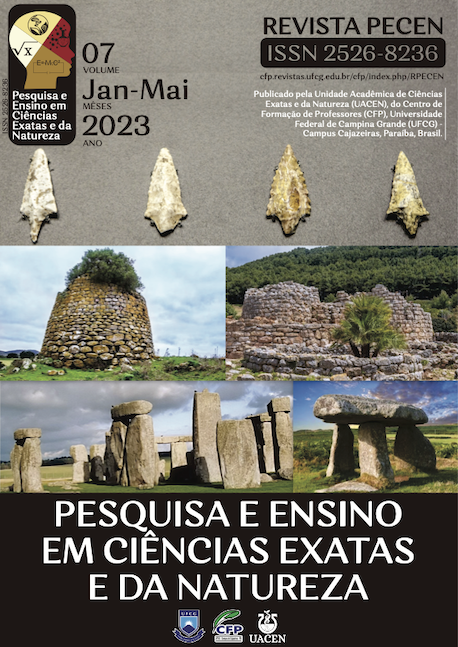
Pesquisa e Ensino em Ciências Exatas e da Natureza
v. 7 n. 1 (2023)The article entitled O conhecimento geológico do material mineral, uma contribuição para a Arqueologia: conceitos e características petrográficas addresses the geological raw material used in the early days of primitive man's life and aims to clarify the mineral nature, concepts and petrographic characteristics. The cover shows lithic artifacts made up of rocks, siliceous minerals and mineraloids with crystalline, microcrystalline, cryptocrystalline and amorphous structures with a cohesive nature, high hardness, great resistance to alteration and fracturing into chips, thus representing important elements for various applications. The cover also shows stone materials from early buildings and domestic objects made of clay and ceramics. Such stone and metal materials were indeed frequent and significant, and represent a potential opportunity to study the transformations experienced by primitive peoples.
-

Pesquisa e Ensino em Ciências Exatas e da Natureza
v. 7 n. 2 (2023)The cover illustration represents the inventory of bird species that occur in Piranhas Velha, Paraíba, northeastern Brazil. In the article in this issue, the species were recorded over a period of 4 months during visits to the study area between November 2021 and February 2022. The active search method was used to identify the species visually in situ or later through photographic records. The species studied by Pereira & Medeiros (2023) were categorized into three habitats (urban, semi-urban and rural) to investigate differences in composition between environments with different levels of urbanization.
-
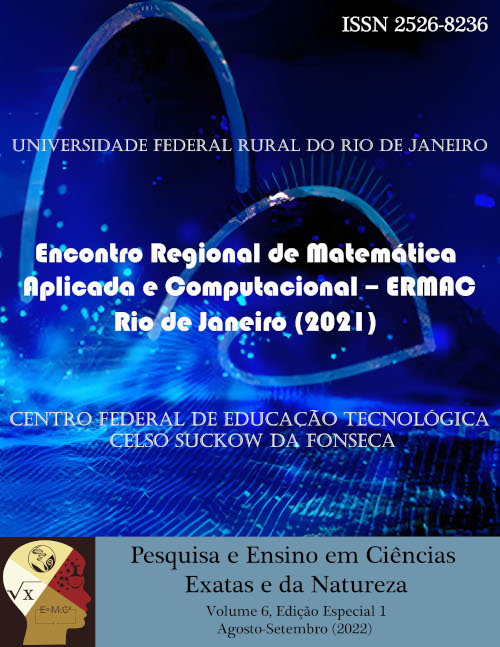
EDIÇÃO ESPECIAL I
v. 6 n. 1 (2022)A Sociedade Brasileira de Matemática Aplicada e Computacional (SBMAC) promove em suas Regionais os Encontros Regionais de Matemática Aplicada e Computacional (ERMAC). Após as edições de 2017 na Universidade Federal Rural do Rio de Janeiro (UFRRJ), Seropédica-RJ, e de 2018, na Universidade Federal do Espírito Santo (UFES), São Mateus-ES, a Regional 06, que corresponde aos Estados do Espírito Santo e Rio de Janeiro, promoveu a edição 2021, realizada em formato remoto pelas instituições UFRRJ e Centro Federal de Educação Tecnológica Celso Suckow da Fonseca (CEFET-RJ). O objetivo do ERMAC é divulgar a produção, valorizar os esforços e fomentar iniciativas que envolvam a matemática aplicada e computacional, particularmente, junto as instituições de ensino e pesquisa dos estados do Rio de Janeiro e Espírito Santo. O evento foi gratuito, online e destinado aos alunos de graduação, pós-graduação bem como a professores e pesquisadores da área de matemática aplicada e computacional e áreas afins. O evento envolveu as seguintes áreas temáticas: Análise Aplicada, Biomatemática, Computação Científica, Computação gráfica, Controle e Teoria de Sistemas, Cálculo Fracionário e Aplicações, Matemática Aplicada e Ensino, Matemática Aplicada à Economia e a Finanças, Matemática Aplicada à Engenharia, Matemática Aplicada à Física, Matemática discreta, Mecânica dos Fluidos e Aplicações, Métodos Estocásticos e Estatísticos, Métodos Numéricos e Aplicações, Otimização, Problemas Inversos, Processamento de Sinais etc. A edição do ERMAC de 2021 contou com palestras, minicursos e apresentação de trabalhos. A imagem da capa desta edição mostra uma configuração eletrônica do monumento natural dos morros do Pão de Açúcar, um complexo de morros localizado no bairro da Urca, cidade do Rio de Janeiro, Brasil. Créditos: Divisão de Programação Visual (DPROV) do CEFET/RJ.
-
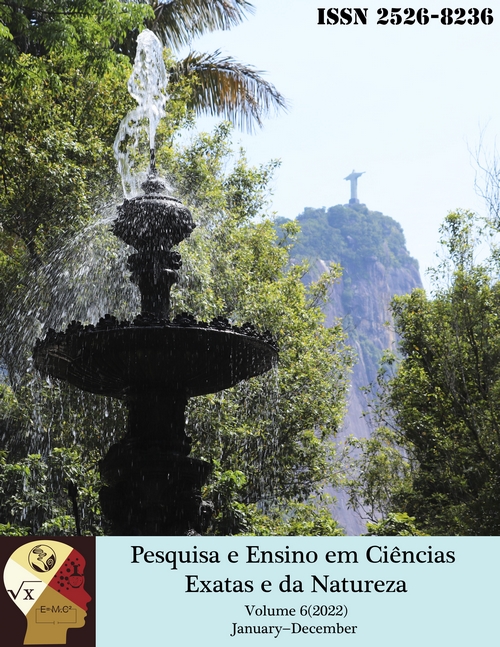
Pesquisa e Ensino em Ciências Exatas e da Natureza
v. 6 (2022)The Instituto de Pesquisas Jardim Botânico do Rio de Janeiro is one of the oldest institutions in Brazil. Its origins date back to the Horto de Aclimatação created by Dom João VI in 1808. It is currently one of the most important research institutions in Brazil. In addition to its great importance for Brazilian science, it is also an important tourist spot in the city. Located in the Zona Sul of Rio de Janeiro, it is close to other tourist sites, such as Lagoa Rodrigo de Freitas. Despite the undoubted importance of the botanical collections of the Jardim Botânico, a rich fauna can also be found in the arboretum. Organized in alleys with plants from all over the planet, some water bodies are also found in this place. To better understand the fauna of these water bodies, the work “Beyond plants: diversity of freshwater molluscs at Instituto de Pesquisas Jardim Botânico do Rio de Janeiro” presents the diversity of freshwater molluscs in this important research institute. Six native and four invasive species were found. Thus, in addition to the maintenance of plant species, we also find an important fauna of freshwater molluscs in the Jardim Botânico. Despite the invasive species, urban green areas can also act as a refuge for some species of our fauna. Especially when these are adjacent to Protected Areas, as is the case of the Botanical Garden, which is close to the Parque Nacional da Tijuca. In the image that illustrates the cover of this edition, we see the apex of the Chafariz das Musas, which was one of the sampling points in the Jardim Botânico, and in the background, the Corcovado, which is located inside the Tijuca National Park.
-
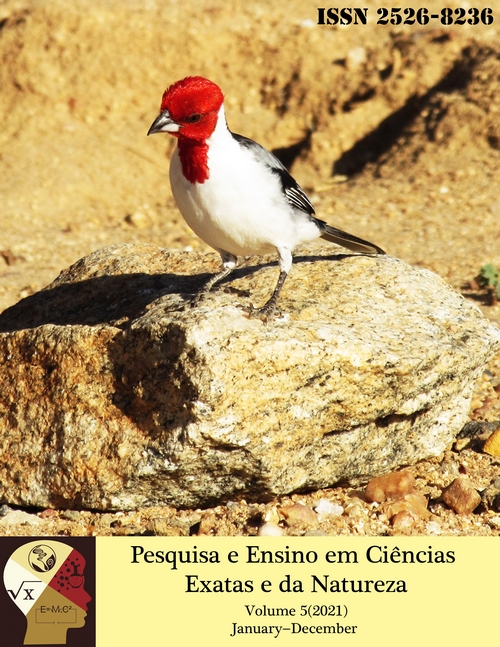
Pesquisa e Ensino em Ciências Exatas e da Natureza
v. 5 (2021)A capa mostra a Paroaria dominicana (Linnaeus, 1758), uma ave passeriforme pertencente à família Thraupidae Cabanis, 1847 e ao gênero Paroaria Bonaparte, 1832. Popularmente denominada de “galo-de-campina” ou “cardeal-do-nordeste” é uma espécie endêmica da Caatinga, tendo cerca de 17 cm de comprimento e uma inconfundível aparência, por conta das penas vermelhas na cabeça e plumagem leucística (uma particularidade genética, onde o gene recessivo, confere a cor branca a animais geralmente escuros), o que a torna resistente ao calor e adaptada ao clima Semiárido. Paroaria dominicana é uma ave, predominantemente, granívora com preferência por sementes de gramíneas, mas eventualmente podendo se tornar insetívora. A espécie vive em pequenos grupos ou aos pares (casais) durante a reprodução, e habita os diferentes domínios fitogeográficos da Caatinga com distribuição geográfica na região Nordeste, mas em virtude do tráfico de animais silvestres, podem ser encontrados no Sudeste, e nos estados de Goiás (Centro-oeste) e Tocantins (Norte). A escolha desta ave para compor a capa, consiste na importância da espécie para a biodiversidade da Caatinga, além de representar uma das características mais proeminentes da cultura nordestina, a resistência, como bem disse Euclides da Cunha, “o sertanejo é antes de tudo um forte”, que pode ser relacionado às estratégias de Convivência com o Semiárido, uma forma de construir relações harmoniosas entre o ser humano e a natureza, evidenciados em um dos artigos que contempla esta edição.
-
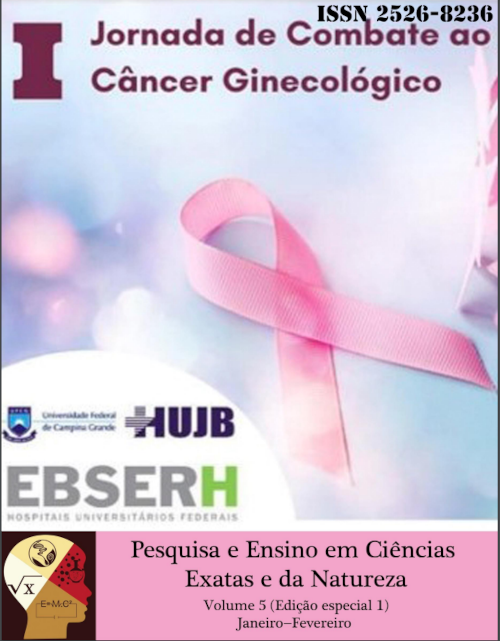
EDIÇÃO ESPECIAL I
v. 5 n. 1 (2021)O Hospital Universitário Júlio Bandeira (HUJB) realizou entre os dias 26 e 30 de outubro de 2020, a I Jornada de Combate ao Câncer Ginecológico (em alusão ao outubro Rosa), um evento extremamente importante relacionado a saúde da mulher. O evento gratuito foi realizado de forma online e contou com a participação de palestrantes de todo o Brasil com reconhecida expertise na área, bem como com a apresentação de trabalhos científicos. O público-alvo envolveu profissionais, docentes, discentes, Instituições de Ensino Superior e a população em geral. O HUJB da Universidade Federal de Campina Grande (UFCG) participa da Empresa Brasileira de Serviços Hospitalares (Ebserh) desde dezembro de 2015. Vinculada ao Ministério da Educação (MEC), a Ebserh foi criada em 2011 e, atualmente, administra 40 hospitais universitários federais, apoiando e impulsionando suas atividades por meio de uma gestão de excelência. Como hospitais vinculados a universidades federais, essas unidades têm características específicas: atendem pacientes do Sistema Único de Saúde (SUS), e, principalmente, apoiam a formação de profissionais de saúde e o desenvolvimento de pesquisas. Devido a essa natureza educacional, os hospitais universitários são campos de formação de profissionais de saúde. Com isso, a Rede Ebserh atua de forma complementar ao SUS, não sendo responsável pela totalidade dos atendimentos de saúde do país. Esta edição especial do periódico Pesquisa e Ensino em Ciências Exatas e da Natureza vinculado a Unidade Acadêmica de Ciências Exatas e da Natureza (UACEN) do Centro de Formação de Professores (CFP) da UFCG destina-se aos trabalhos premiados na I Jornada de Combate ao Câncer Ginecológico promovido pelo HUJB. Os créditos da arte da capa desta edição especial são destinados a empresa Ideia, localizada na cidade de Cajazeiras, estado da Paraíba.
-
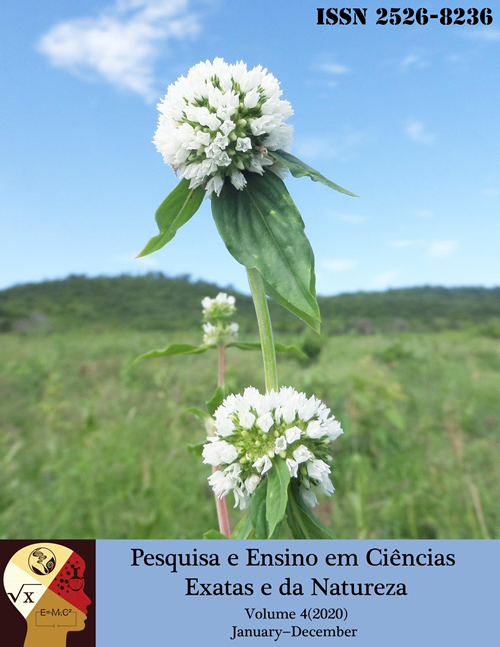
Pesquisa e Ensino em Ciências Exatas e da Natureza
v. 4 (2020)The cover shows Borreria spinosa Cham. et Schltdl. ex DC., a member of Rubiaceae, which is the fourth largest family of flowering plants (angiosperms) currently in nature. Commonly known as “cabeça de velho” [old man’s head], it is recognized by its globose inflorescence composed of numerous white flowers. This plant occurs in all five regions of Brazil in the phytogeographic domains of the Caatinga, Cerrado and Atlantic Forest. The image also shows part of the Arara Hills in the background, located in the semi-arid region of the state of Paraíba, which has important floristic richness revealed to the scientific community for the first time in the article printed in this edition.
-
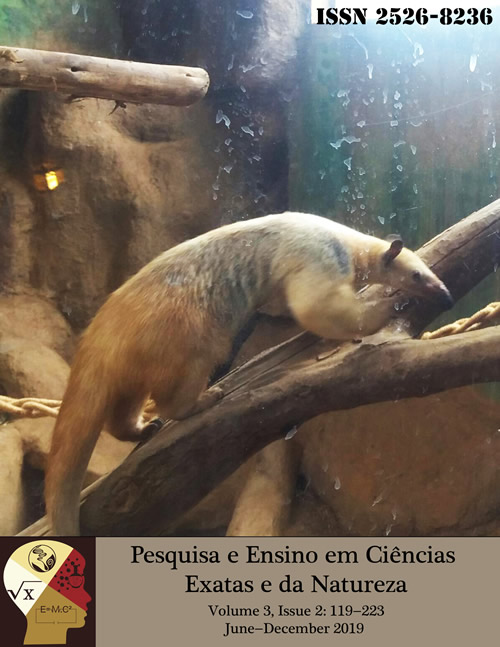
Pesquisa e Ensino em Ciências Exatas e da Natureza
v. 3 n. 2 (2019)The cover photo shows a female subject of southern tamandua (Tamandua tetradactyla) kept at Aquário de São Paulo performing the "climbing" behavior. By performing this behavior, the subject climbed its enclosure's elements such as the trunk (photo). During the observations two subjects (a male and a female) were studied regarding their behaviors while in the presence and absence of environmental enrichments, which would be important for us to understand how environmental enrichments would have influenced these subjects' behavior. The photo shows the moment when the observers were getting to know these subjects to understand the enclosure where the observations would be conducted. Photo by Maryana Tursi and Fernanda Buck.
-
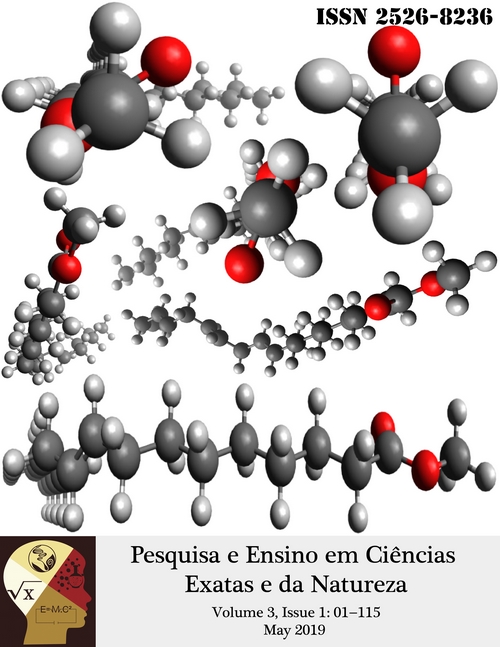
Pesquisa e Ensino em Ciências Exatas e da Natureza
v. 3 n. 1 (2019)A quantum-mechanical, ab-initio-level study using the Hartree-Fock-Roothaan theory was performed on the major constituents of soybean oil. The front cover image, constructed with the free Avogadro and GIMP software, shows structures of these constituents, which are the results of the study (see article by Araújo et al. in this edition). The energy data of each of these molecules demonstrate that biodiesel obtained from soybean oil is unstable, since the percentage of unstable compounds in its constitution is higher for methyl ester molecules with 18 carbon atoms and one or two unsaturations. This finding is in agreement with data described by other authors, who they admit that biodiesel from soybean oil tends to undergo oxidation reactions easily. Thus, due to its oxidative instability, this biofuel should be well stored and not exposed.
-
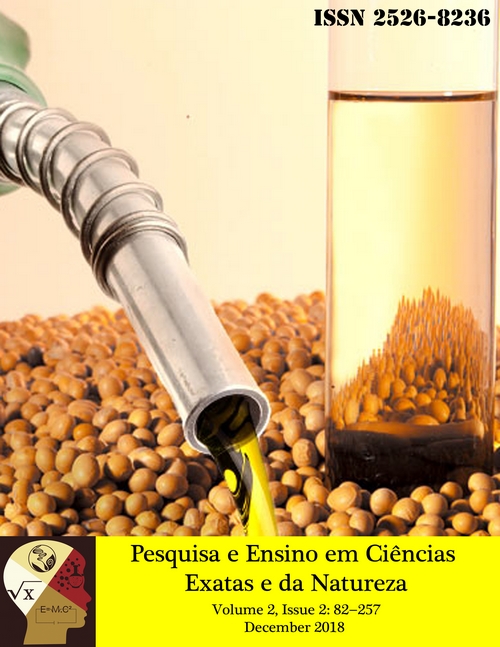
Pesquisa e Ensino em Ciências Exatas e da Natureza
v. 2 n. 2 (2018)The Exame Nacional do Ensino Médio (Enem) has used biofuel as the topic of questions since the implementation in 2004 of an inter-ministerial program of the Federal Government denominated the Programa Nacional de Produção e Uso do Biodiesel (PNPB), the aim of which is to find sustainable alternatives to the use of diesel oil. The basis of this program is the development of family farming and investments in scientific research to improve the production and use of biofuel. With this subject in mind, Freire et al. (see article in this edition) sought to understand the profile of questions addressing biofuel on the NHSE, considering the national context and the presentation of information on biofuel. The authors selected a total of nine out of a universe of 1503 questions between 1998 and 2017 and found that, beginning in 2003, the NHSE addressed the issue of the transformation of vegetal oil into biofuel through the transesterification reaction and policies regarding use and production. The cover photo was courtesy of MultiPetro – Diesel Oil and Petroleum Product Distributor, which is one of the main biofuel distributors in the state of Paraná. MultiPetro has been supporting sustainability and, consequently, a better world for us all. The photo was originally published on May 25th, 2017, on the company's website and shows soybeans, which constitute one of the main raw materials for the production of biofuel in Brazil.
-

Pesquisa e Ensino em Ciências Exatas e da Natureza
v. 2 (2018)The Encontro Regional de Matemática Aplicada e Computacional (ERMAC) and II Simpósio de Matemática Aplicada e Computacional occurred between November 6th and 8th, 2017, at the “Universidade Federal Rural do Rio de Janeiro (UFRRJ)” – Seropédica Campus. These events are important to the dissemination of the field of Applied and Computational Mathematics, since meetings of this type unite students, professors and researchers from the most diverse fields of technology, health and science who use Mathematics as a tool to describe their activities; motivate teaching (on all levels), research and development activities regarding Applied and Computational Mathematics; encourage programs and joints actions with teaching and research institutes; and disseminate research and extension activities. Moreover, researchers make significant contributions in the form of lectures and mini-courses on relevant, current topics with undeniable quality. The “Sociedade Brasileira de Matemática Aplicada e Computacional (SBMAC)” promotes an annual regional encounter. This is a not-for-profit civil society with an unlimited number of members with objectives directed at the field of Applied and Computational Mathematics. The photo on the cover shows the garden of the main building of the UFRRJ – Seropédica Campus, location of the ERMAC in 2017. The photo was provided by Prof. Dr. Mauro de Freitas Rebelo (UFRJ/IBCCF).
-
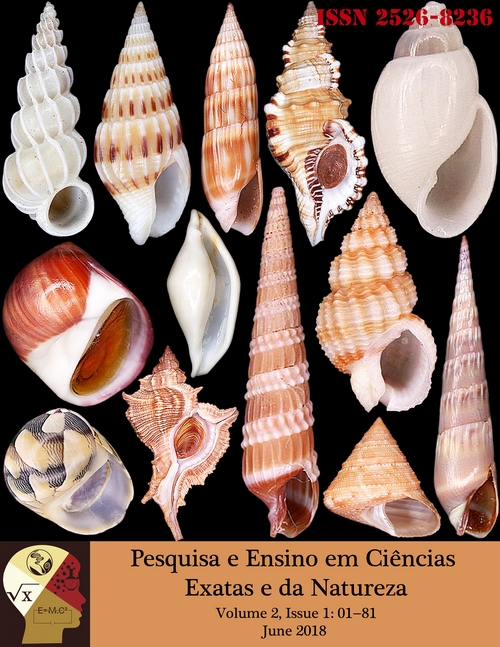
Pesquisa e Ensino em Ciências Exatas e da Natureza
v. 2 n. 1 (2018)The cover photo shows some of the species of benthic mollusks belonging to the class Gastropoda collected by Gernet et al. in Farol Island, a continental island located on the coast of the State of Paraná, Southern Brazil. Gernet et al. studied the diversity and composition of the marine mollusks (Bivalvia, Gastropoda, and Scaphopoda) from the Farol Island, from individuals collected in three distinct environments (open water, estuary, and sandy beach), finding a total of 91 species. Gastropoda (Mollusca class with the highest species richness) was the most abundant and diversified group representing about 90% of the species studied in Farol Island (see the full article of Gernet et al. in this issue). The photographs of the shells used on the cover were provided by the “Conquiliologistas do Brasil” (2001-2018), one of the main entities active in the field of Conquiliology in Latin America. Conquiliology is part of the Zoology that deals with the study of shells.
-
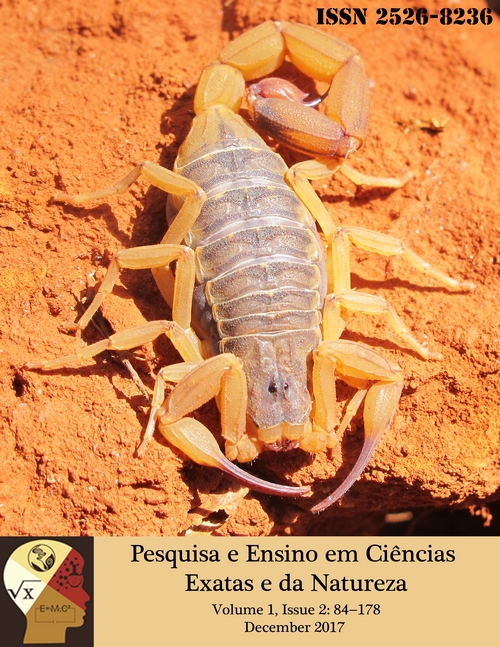
Pesquisa e Ensino em Ciências Exatas e da Natureza
v. 1 n. 2 (2017)The photo shows an individual of Tityus serrulatus. This exotic species is found in the Northeast and Central-West regions, being responsible for most of the scorpionic accidents in Brazil. In the municipality of Fortaleza, it is one of the main species that cause accidents, despite the statistics of the Notification of Invalidity Information System (SINAN) not mentioning its occurrence for the State. The proposal of the work of Azevedo et al. is to correlate the SINAN accident data with the geographic distribution of species of health interest in the scientific collections of arachnids, thus delimiting, in fact, which species of health interest occur in the State of Ceará. Photo: Pedro H. Martins.
-
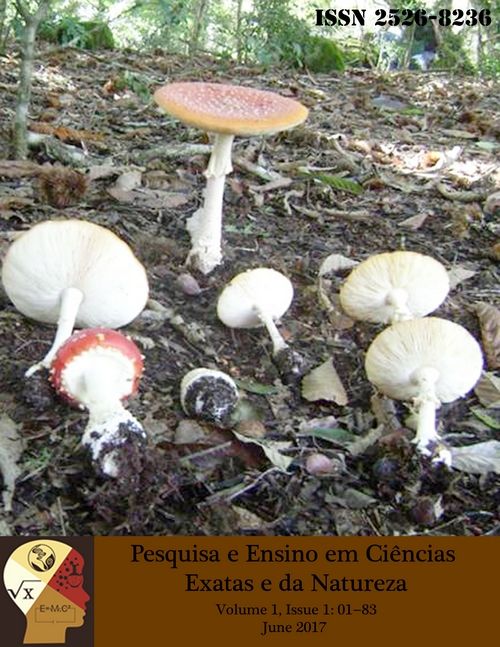
Pesquisa e Ensino em Ciências Exatas e da Natureza
v. 1 n. 1 (2017)Photograph of specimens of Amanita muscaria var. muscaria taken by Felipe Wartchow (see article in this edition) under Castanea sativa (exotic tree brought from Europe) in São Francisco de Paula National Forest in the state of Rio Grande do Sul. In this edition, Felipe Wartchow published a literature review on historic aspects related to the Taxonomy, Systematics and geographic distribution of fungi of the genus Amanita in Brazil.

